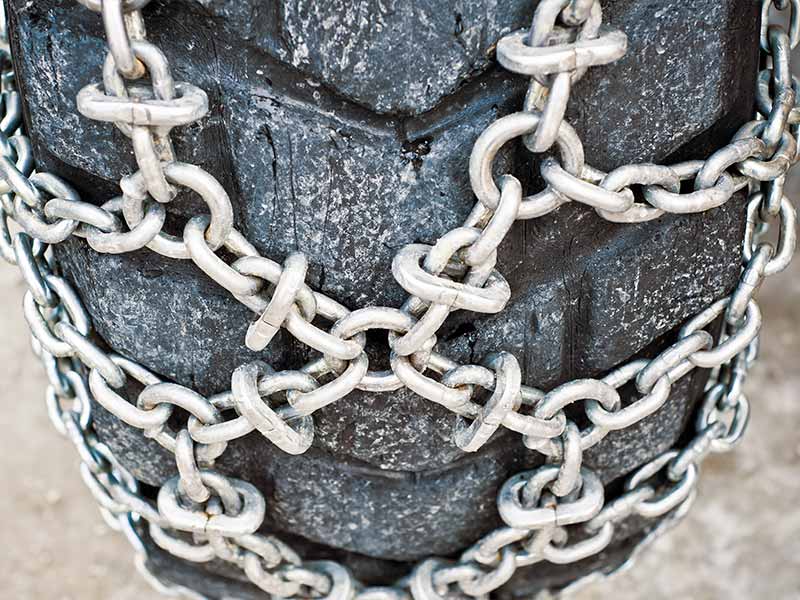Driving in snow and ice with improper or inadequate traction can be downright terrifying. Slipping all over the place with your heart in your throat is zero fun. But something as simple as snow chains can make winter driving way less nerve-wracking.
How To Drive With Snow Chains
You can drive safely with snow chains at lower speeds by accelerating and turning gently, keeping longer stopping distance, and closely following the usage guidelines.
In This Article I’ll explain when to install chains, how to put them on correctly, smart driving tips once they’re on, and the proper way to take them off and store them after use.
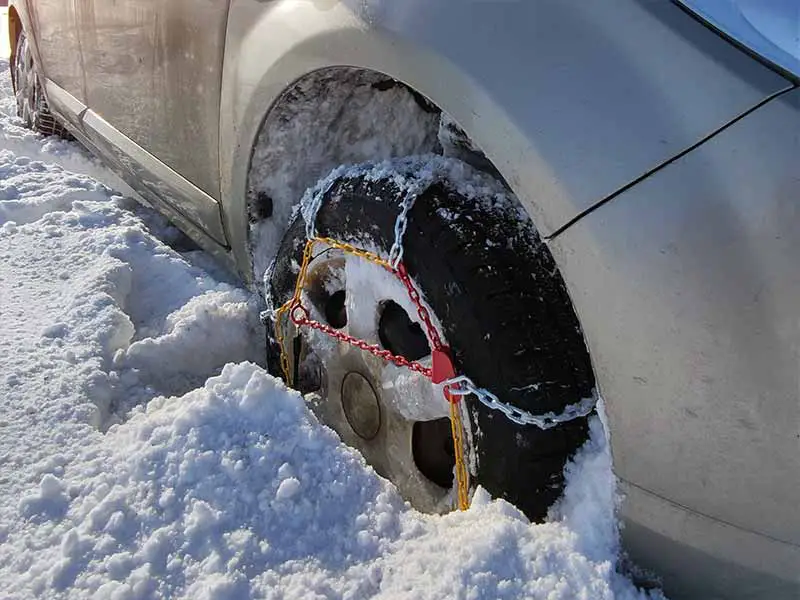
When to Use Snow Chains
Snow chains provide additional traction and control when driving in wintry conditions, but it’s important to use them only when truly needed. I advise drivers to consider using chains when:
- Roads have accumulated 3-4 inches of unplowed snow. Chains help “bite” through fresh powder to grip the road underneath. Any less snow and they may damage your tires and vehicle.
- Compacted snow and ice makes roads extremely slippery. Chains supply grip regular tires cannot.
- You’re traveling across mountain passes or rural areas in harsh winter storms. Help may be far away if you get stuck.
- Vehicle traction control or stability systems activate due to wheel slip. Chains may provide control assistance.
- You’re driving a rear-wheel drive vehicle lacking proper winter tires. Chains boost traction for propelling and steering the vehicle.
- Visibility is very poor and speeds must be kept low. Chains allow safe forward progress in whiteout conditions.
However, some caution about over-relying on chains is warranted. They aren’t a fix-all for unsafe winter driving if you lack experience navigating snowy/icy roads. Consider improving your winter driving knowledge and skills in concert with using chains when absolutely necessary.
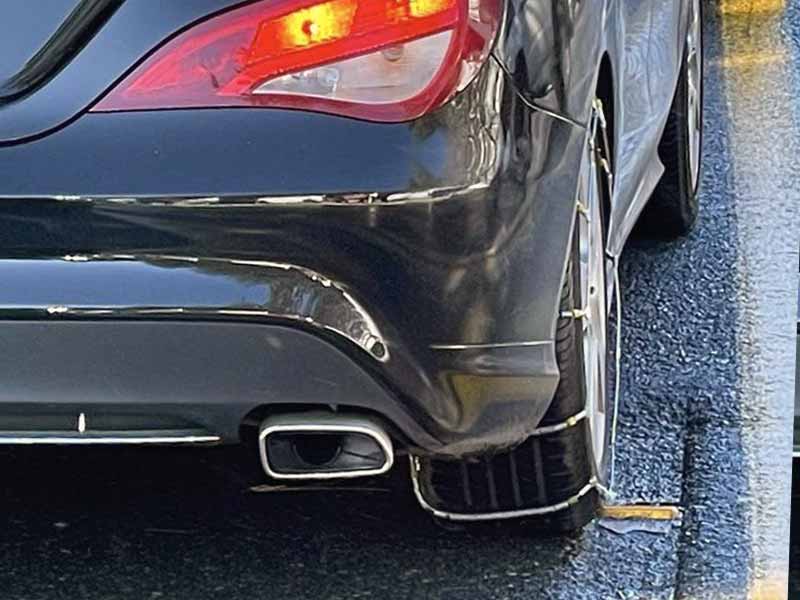
Which Tires To Put Chains On Your Vehicle
I always recommend referring to your owner’s manual when deciding when to put snow chains on your tires. Vehicle manufacturers provide guidance based on your specific model’s capabilities in snow and ice. Some key recommendations they make:
- Front-wheel drive vehicles – Chains are often only recommended for the front tires since that’s where the engine delivers the power to move the vehicle. Rear wheels just roll freely.
- Rear-wheel drive vehicles – Chains should be installed on the rear tires on rear-wheel drive vehicles. The back wheels propel the vehicle forward.
- All-wheel/Four-wheel drive vehicles – Check manufacturer guidance, as some recommend chains only on front or rear. Others suggest chains on all four tires for max traction.
- Vehicles with traction control systems – Chains can interfere with electronic stability control. Again, confirm what’s advised for your specific vehicle.
Beyond the owner’s manual guidance, I recommend considering chains when:
- There is heavy snow and ice accumulation on the roads
- Winter weather forecasts call for extreme conditions
- You must drive through mountain passes or other remote areas in the snow
Installing chains takes some time and effort, so I don’t advise waiting until you’ve gotten stuck in the snow to put them on. Be proactive when the conditions warrant them. Your safety is most important.
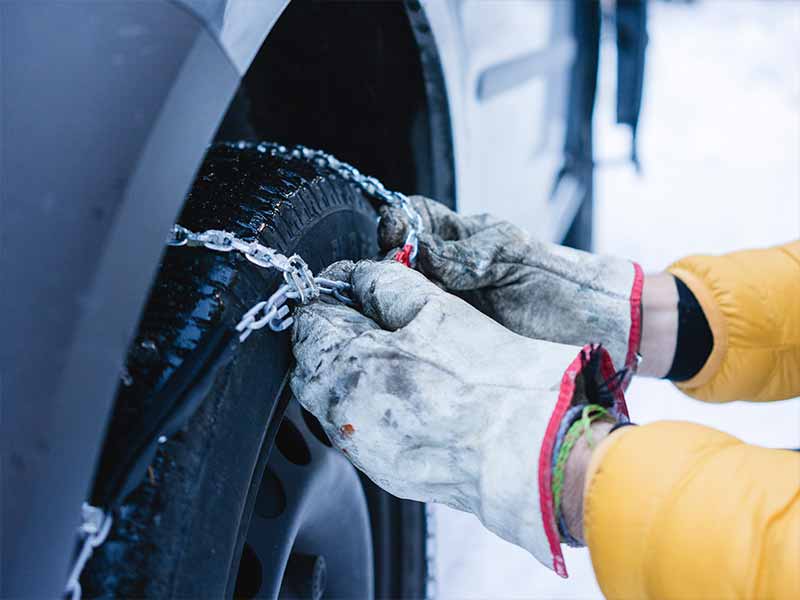
How to Properly Install Snow Chains
Installing tire chains takes some time and effort. I always emphasize doing so in a safe location, with proper equipment, and by closely following the manufacturer’s instructions. Here are my top tips:
- Park smart – Get completely off the road on a flat, firm surface if possible. Engage your parking brake and turn on your hazard lights.
- Protect your hands – Wear gloves to protect your hands from the cold metal and sharp chain parts during installation.
- Unload before lifting – Chains go on easier when the tire has less weight pressing down on it. Remove heavy items from your car prior to installing chains.
- Mind the instructions – Chains differ, so follow the step-by-step guide that came with yours. Using the manufacturer video tutorials can be extremely helpful too.
- Fit snug, not tight – The chains should fit snugly around the tires with 1⁄4 – 1⁄2 inch of slack. Too loose and they’ll fly off. Too tight and they can damage your tires.
- Secure the hooks – Double check that all securement hooks are properly connected once the chains are on. These hold the chains firmly to the tire tread.
- Check clearance – Inspect that no part of the chains is contacting any suspension component or rubbing on the vehicle body.
Taking time to correctly put chains on can pay major dividends in terms of safe winter driving.
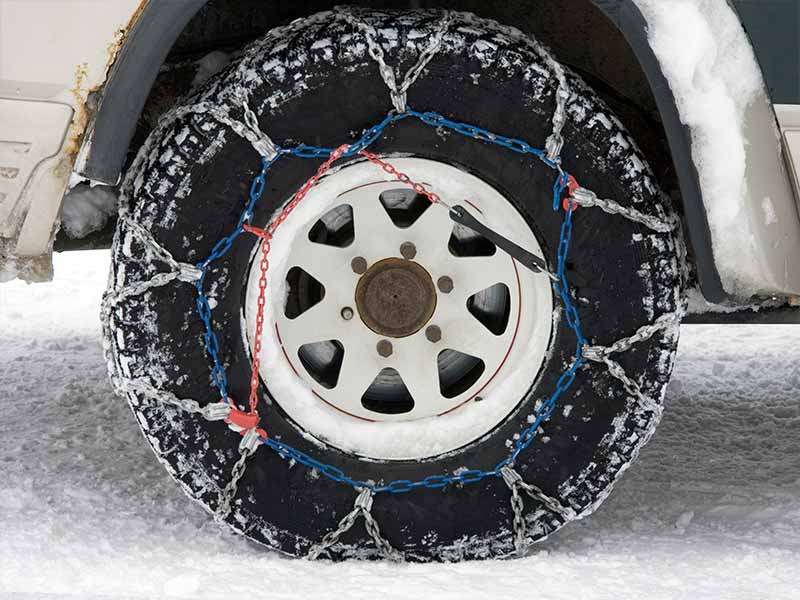
Driving With Snow Chains Installed
Once your snow chains are securely installed, you can proceed to drive, but be aware that chains impact vehicle handling and braking.
I recommend all drivers:
- Observe lower speed limits – Most chain manufacturers advise staying under 30 mph. Higher speeds overstress the chains and cause them to wear out faster. They also negatively impact vehicle control.
- Accelerate and brake gently – Sudden acceleration or braking can cause chains to slip or dislodge. Smooth, gradual inputs are key.
- Avoid aggressive steering – Similar to braking and acceleration, quick, sharp turns put more force on the chains. Drive a little slower and steer more gently.
- Allow extra following distance – Increase the gap between yourself and the vehicle ahead. Chains don’t stop or steer your vehicle as efficiently. More space cushions against braking issues.
- Stay alert – Chains throw up some snow and ice as you drive. Keep an eye out for any chain parts coming loose so you can pull over if an issue develops.
Following these tips helps ensure you, your vehicle, and your chains make it through severe winter conditions safely.
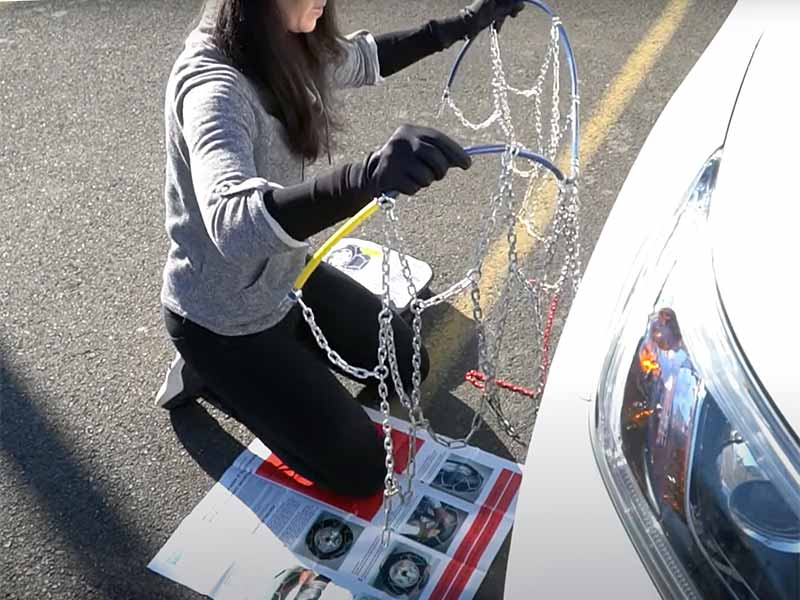
Removing Snow Chains
Just as proper installation is key, carefully taking snow chains off your tires is critical too. Follow these tips for safe removal and storage:
- Wait for clearing conditions – I recommend removing chains only once you’ve reached clear roads that are plowed down to pavement. Trying to take them off while still on snow and ice is hazardous.
- Park safely first – Get fully out of any traffic area in a flat, secure spot before removing chains. Engage your parking brake again and turn on hazards.
- Inspect for damage – Once chains are off, examine them and your tires closely for any worn or damaged parts. The sooner you catch and can replace anything compromised, the better.
- Clean diligently – Chains get dirty and muddy during use. Knock off debris and vigorously brush them down before storing so they don’t rust.
- Air dry completely – Never put chains away when wet. The moisture promotes rust if stored and can freeze them together if left overnight.
- Mind the hooks – Carefully reconnect any over-the-tire hooks and drape chains loosely rather than tangling for organized storage.
- Use a dedicated bin – I’m a big believer in a plastic storage container just for chains in a garage or vehicle. Keeps them protected and separate from other stuff.
Removing chains properly after driving helps maximize their lifespan so you get the most use from your valuable set before having to buy new chains.
Resources
Below are some links you may find helpful when learning about tires
- How to: Put on snow chains and drive safely – Les Schwab
- How to drive with car tire chains – On The Snow
Final Thoughts
The most important takeaways about driving with snow chains are to carefully follow manufacturer guidance on installation and usage, moderate your speed and driving style to account for traction changes, and diligently maintain and store your chains when not needed. Employing snow chains with informed care makes winter travel markedly less perilous.
Good luck and happy motoring.
